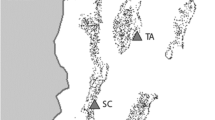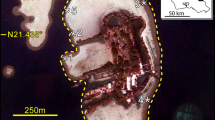Abstract
Marine invasive species are pervasive across the world’s coastal regions. Nevertheless, empirical quantification of their ecological effects remains limited. Here, we elucidate the interaction of the invasive silver-cheeked toadfish, Lagocephalus sceleratus, with the fish community of the Eastern Mediterranean Sea, a hotspot for marine biological invasions. We deployed 88 underwater stereo-video systems across the Israeli continental shelf and upper slope. From this data, we quantified the change in fish behavior in the absence and presence of L. sceleratus. We further supported our findings by analyzing L. sceleratus gut contents. Our results indicated that the presence of L. sceleratus significantly deterred other non-indigenous species (NIS) and we recorded multiple NIS escape behaviors (fleeing, covering beneath sand or algae, or using camouflage). However, indigenous species (IS), for the most part, remained indifferent to L. sceleratus’ presence. Furthermore, analysis of gut contents supported the visual surveys and revealed that L. sceleratus primarily feed on NIS, including other non-indigenous pufferfish species. Our findings suggest that harmful invasive species may not necessarily be detrimental to IS. At the same time, the apparent threat by L. sceleratus may have ecological impacts on other NIS, especially invasive pufferfishes which are highly poisonous and are suspected to have few predators in the Mediterranean Sea.


Similar content being viewed by others
Data availability
The datasets in this current study have not been released as they are part of an ongoing field work. They may be requested from the corresponding author.
References
Akyol O, Unal V, Ceyhan T, Bilecenoglu M (2005) First confirmed record of Lagocephalus sceleratus (Gmelin, 1789) in the Mediterranean Sea. J Fish Biol 66:1183–1186. https://doi.org/10.1111/j.0022-1112.2005.00667.x
Anton A, Geraldi NR, Lovelock CE et al (2019) Global ecological impacts of marine exotic species. Nat Ecol Evol 3:787–800. https://doi.org/10.1038/s41559-019-0851-0
Bilecenoğlu M (2005) Observations on the burrowing behaviour of the Dwarf Blaasop, Torquigener flavimaculosus (Osteichthyes: Tetraodontidae) along the coast of Fethiye, Turkey. Zool Middle East 35:29–34. https://doi.org/10.1080/09397140.2005.10638100
Bolker BM, Nielsen A, Berg CW et al (2017) glmmTMB balances speed and flexibility among packages for zero-inflated generalized linear mixed modeling. ETH Zurich. https://doi.org/10.3929/ethz-b-000240890
Brown TR, Coleman RA, Swearer SE, Hale R (2018) Behavioral responses to, and fitness consequences from, an invasive species are life-stage dependent in a threatened native fish. Biol Conserv 228:10–16. https://doi.org/10.1016/j.biocon.2018.10.003
Champneys T, Ferry K, Tomkinson S et al (2022) Simulated encounters with a novel competitor reveal the potential for maladaptive behavioural responses to invasive species. Biol Invasions 24:845–860. https://doi.org/10.1007/s10530-021-02690-6
Coro G, Vilas LG, Magliozzi C et al (2018) Forecasting the ongoing invasion of Lagocephalus sceleratus in the Mediterranean Sea. Ecol Modell 371:37–49. https://doi.org/10.1016/j.ecolmodel.2018.01.007
D’Agostino D, Jimenez C, Reader T et al (2020) Behavioural traits and feeding ecology of Mediterranean lionfish and naiveté of native species to lionfish predation. Mar Ecol Prog Ser 638:123–135. https://doi.org/10.3354/meps13256
Diga R (2021) Small-scale ecological effects of invading bivalves in the Levantine basin. Master thesis
Edelist D, Rilov G, Golani D et al (2013) Restructuring the Sea: profound shifts in the world’s most invaded marine ecosystem. Diversity Distrib 19:69–77. https://doi.org/10.1111/ddi.12002
Edelist D, Sonin O, Golani D, et al (2011) Spatiotemporal patterns of catch and discards of the Israeli Mediterranean trawl fishery in the early 1990s ecological and conservation perspectives. Sci Mar 75: 641–652.
Galil BS (2008) Alien species in the Mediterranean Sea—which, when, where, why? In: Davenport J, Burnell GM, Cross T et al (eds) Challenges to marine ecosystems. Springer, Netherlands, Dordrecht, pp 105–116
Givan O, Parravicini V, Kulbicki M, Belmaker J (2017) Trait structure reveals the processes underlying fish establishment in the Mediterranean. Glob Ecol Biogeogr 26:142–153. https://doi.org/10.1111/geb.12523
Goetze JS, Januchowski-Hartley FA, Claudet J et al (2017) Fish wariness is a more sensitive indicator to changes in fishing pressure than abundance, length or biomass. Ecol Appl 27:1178–1189. https://doi.org/10.1002/eap.1511
Green SJ, Akins JL, Maljković A, Côté IM (2012) Invasive lionfish drive Atlantic coral reef fish declines. PLoS ONE 7:e32596. https://doi.org/10.1371/journal.pone.0032596
Gurevitch J, Padilla DK (2004) Are invasive species a major cause of extinctions? Trends Ecol Evol 19:470–474. https://doi.org/10.1016/j.tree.2004.07.005
Harvey E, Shortis M (1995) A system for stereo-video measurement of sub-tidal organisms. Marine Technology Society Journal
Kalogirou S (2013) Ecological characteristics of the invasive pufferfish Lagocephalus sceleratus (Gmelin 1789) in the eastern Mediterranean Sea – a case study from Rhodes. Medit Mar Sci 14: 251. https://doi.org/10.12681/mms.364
Katsanevakis S, Wallentinus I, Zenetos A, et al (2014) Impacts of invasive alien marine species on ecosystem services and biodiversity: a pan-European review. AI 9: 391–423. https://doi.org/10.3391/ai.2014.9.4.01
Kosker AR, Özogul F, Ayas D et al (2019) Tetrodotoxin levels of three pufferfish species (Lagocephalus sp.) caught in the North-Eastern Mediterranean sea. Chemosphere 219:95–99. https://doi.org/10.1016/j.chemosphere.2018.12.010
Kosker AR, Özogul F, Durmus M et al (2018) First report on TTX levels of the yellow spotted pufferfish (Torquigener flavimaculosus) in the Mediterranean Sea. Toxicon 148:101–106. https://doi.org/10.1016/j.toxicon.2018.04.018
Kovacic M, Lipej L, Dul J, et al (2021) Evidence-based checklist of the Mediterranean Sea fishes. Zootaxa 4998:1–115. https://doi.org/10.11646/zootaxa.4998.1.1
Langlois T, Goetze J, Bond T et al (2020) A field and video annotation guide for baited remote underwater stereo-video surveys of demersal fish assemblages. Methods Ecol Evol. https://doi.org/10.1111/2041-210X.13470
Mavruk S, Bengil F, Yeldan H et al (2017) The trend of lessepsian fish populations with an emphasis on temperature variations in Iskenderun Bay, the Northeastern Mediterranean. Fish Oceanogr 26:542–554. https://doi.org/10.1111/fog.12215
Molnar JL, Gamboa RL, Revenga C, Spalding MD (2008) Assessing the global threat of invasive species to marine biodiversity. Front Ecol Environ 6:485–492. https://doi.org/10.1890/070064
Paolucci EM, MacIsaac HJ, Ricciardi A (2013) Origin matters: alien consumers inflict greater damage on prey populations than do native consumers. Divers Distrib 19:988–995. https://doi.org/10.1111/ddi.12073
Seebens H, Blackburn TM, Dyer EE et al (2017) No saturation in the accumulation of alien species worldwide. Nat Commun 8:14435. https://doi.org/10.1038/ncomms14435
Ulman A, Harris HE, Doumpas N et al (2021a) Low pufferfish and lionfish predation in their native and invaded ranges suggests human control mechanisms may be necessary to control their mediterranean abundances. Front Mar Sci. https://doi.org/10.3389/fmars.2021.670413
Ulman A, Kalogirou S, Pauly D (2022) The Dynamics of maximum lengths for the invasive silver-cheeked toadfish (Lagocephalus sceleratus) in the Eastern Mediterranean Sea. JMSE 10:387. https://doi.org/10.3390/jmse10030387
Ulman A, Yildiz T, Demirel N, et al (2021b) The biology and ecology of the invasive silver-cheeked toadfish (Lagocephalus sceleratus), with emphasis on the Eastern Mediterranean. NB 68: 145–175. https://doi.org/10.3897/neobiota.68.71767
Vergés A, Tomas F, Cebrian E et al (2014) Tropical rabbitfish and the deforestation of a warming temperate sea. J Ecol 102:1518–1527. https://doi.org/10.1111/1365-2745.12324
Watkins HV, Yan HF, Dunic JC, Côté IM (2021) Research biases create overrepresented “poster children” of marine invasion ecology. Conserv Lett. https://doi.org/10.1111/conl.12802
Acknowledgements
We thank Shahar Malamud for his assistance at sea and logistic support throughout the field work. We thank James Seager for his technical support and rapid response with CAL, EventMeasure, and the design of camera frames. We thank Dr. Shevy Bat-Sheva Rothman for her dedicated help in identifying some of the species in the videos. We thank Prof. Bella S. Galil for her assistance in gut content identification. We thank Daphna Shapiro Goldberg for her comments on the manuscript.
Funding
SC received partial funding from the Mediterranean Sea Research Center of Israel (SC). JB received funding from the Grant for Tel-Aviv University center for Artificial intelligence and Data science (TAD) in collaboration with Google.
Author information
Authors and Affiliations
Contributions
SC collected the data, conceived the study, and planned it. SC and GDB analyzed the videos. SC conducted the statistical analysis. SC, GDB, and JB wrote the first draft. NY and NS conducted the gut contents analysis. JB supervised the findings of this work. All authors read, commented on, and approved the final manuscript.
Corresponding author
Ethics declarations
Conflict of interest
The authors declare that they have no conflict of interest.
Additional information
Publisher's Note
Springer Nature remains neutral with regard to jurisdictional claims in published maps and institutional affiliations.
Supplementary Information
Below is the link to the electronic supplementary material.
Supplementary file2 (MP4 456624 kb)
Supplementary file3 (MP4 304206 kb)
Supplementary file4 (MP4 296958 kb)
Supplementary file5 (MP4 188877 kb)
Supplementary file6 (MP4 34925 kb)
Supplementary file7 (MP4 223423 kb)
Rights and permissions
Springer Nature or its licensor (e.g. a society or other partner) holds exclusive rights to this article under a publishing agreement with the author(s) or other rightsholder(s); author self-archiving of the accepted manuscript version of this article is solely governed by the terms of such publishing agreement and applicable law.
About this article
Cite this article
Chaikin, S., De-Beer, G., Yitzhak, N. et al. The invasive silver-cheeked toadfish (Lagocephalus sceleratus) predominantly impacts the behavior of other non-indigenous species in the Eastern Mediterranean. Biol Invasions 25, 983–990 (2023). https://doi.org/10.1007/s10530-022-02972-7
Received:
Accepted:
Published:
Issue Date:
DOI: https://doi.org/10.1007/s10530-022-02972-7




